How to Fertilize Garlic for Maximum Yield: A Comprehensive Guide in 2024
- April 5, 2024
- 0 comment
Discover expert tips on how to fertilize garlic for maximum yield in this comprehensive guide. Boost your harvest with our proven strategies. Welcome to our in-depth exploration on nurturing garlic to achieve its fullest potential. Garlic, beloved for its culinary versatility and health benefits, thrives under careful attention and specific nourishment.
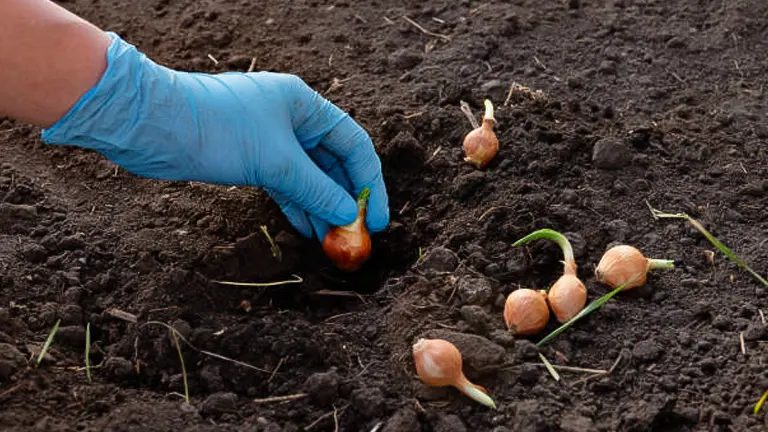
This guide is dedicated to uncovering the expert tips and proven strategies that will help you boost your garlic harvest. Designed for gardeners at every level of experience, our detailed advice ensures your garlic plants receive the perfect mix of nutrients to grow robustly. Join us as we guide you through the essentials of fertilizing garlic, paving the way for a bountiful yield.
Table of Contents
- Understanding Garlic: Its Needs and Growth Cycle
- The Basics of Fertilizing Garlic
- When to Fertilize Garlic
- How to Fertilize Garlic: Step-by-Step Guide
- Watering Practices Post-Fertilization for Garlic
- Advanced Tips for Maximizing Garlic Yield
- Conclusion
- FAQs
Understanding Garlic: Its Needs and Growth Cycle
Garlic Types: Hardneck vs. Softneck
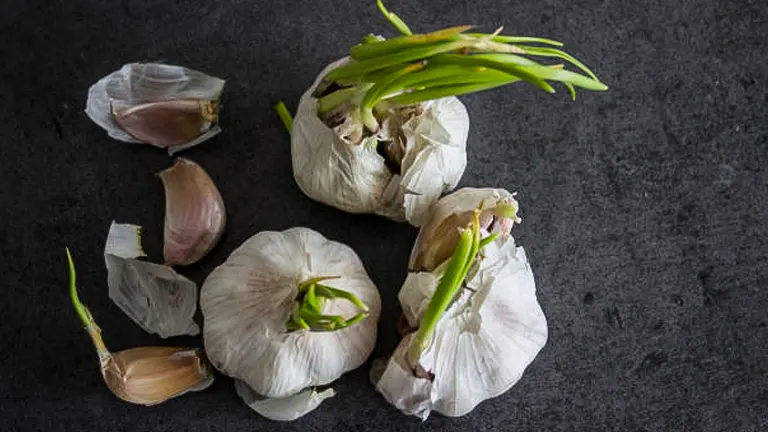
Garlic is broadly classified into two categories, each with distinct characteristics and requirements:
- Hardneck (Allium sativum ophioscorodon): Known for their hard central stalk and formation of scapes, hardneck varieties are often celebrated for their complex and richer flavors. They tend to produce fewer but larger cloves and are more tolerant of cold climates, making them ideal for northern gardeners. Examples include ‘Music’, ‘German White’, and ‘Russian Red’.
- Softneck (Allium sativum sativum): These varieties lack a central stalk and are generally more adaptable to a wider range of climates. Softnecks are preferred for commercial cultivation due to their longer shelf life and higher clove count. ‘California Early’ and ‘Silver Rose’ are popular softneck varieties.
Growth Cycle and Stages of Garlic
- Planting and Root Establishment (October-November): Garlic cloves are planted in fall, where they begin to establish roots before the ground freezes.
- Leaf Development (Early Spring): As temperatures rise, garlic plants resume growth, focusing energy on leaf development. This stage is crucial for photosynthesis, driving subsequent bulb growth.
- Bulb Formation (Late Spring to Early Summer): Triggered by increasing daylight hours, garlic begins to divert energy from leaf growth to bulb formation.
- Maturation and Harvest (Mid to Late Summer): Bulbs continue to grow until leaves begin to brown, indicating readiness for harvest.
Nutritional Needs of Garlic Plants
Garlic’s demand for nutrients varies across its growth cycle, requiring careful management of fertilization:
- Nitrogen (N): Critical for early leaf growth and development. Optimal levels are around 150-200 kg/ha to promote vigorous foliage without compromising bulb size.
- Phosphorus (P): Essential for strong root development and bulb formation. Phosphorus needs are estimated at 50-100 kg/ha, aiding in energy transfer and storage within the plant.
- Potassium (K): Supports overall plant health and disease resistance, with a requirement of approximately 150-200 kg/ha. Potassium improves garlic’s ability to withstand drought and enhances flavor quality.
Unique Information and Scientific Analysis
For the scientifically-minded or those curious about the precise needs of garlic, consider the following table that outlines the nutritional requirements across different stages of growth:
| Growth Stage | Nitrogen (N) | Phosphorus (P) | Potassium (K) | Notes |
|---|---|---|---|---|
| Planting & Root Growth | Low | Medium | Medium | Initial focus on phosphorus for root development. |
| Leaf Development | High | Low | Medium | Nitrogen is key for foliage; avoid excess to prevent lush, unproductive growth. |
| Bulb Formation | Medium | High | High | Balanced NPK to support bulb growth and overall health. |
| Maturation | Low | Low | Low | Reduce fertilization as bulbs mature to encourage natural curing. |
Understanding these nutritional demands and adjusting your fertilization strategy accordingly can significantly impact the quality and size of your garlic harvest. Incorporating soil amendments based on soil tests and selecting the right fertilizer types (organic or synthetic) tailored to these stages can optimize garlic growth and yield.
The Basics of Fertilizing Garlic
Importance of Soil Testing Before Fertilization
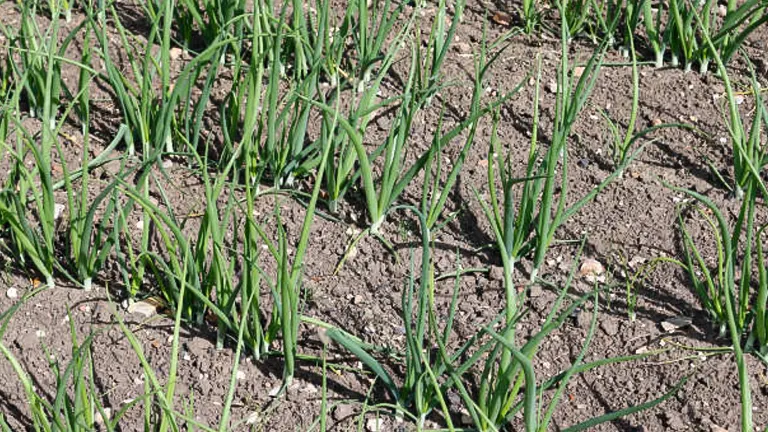
A soil test is not just a preliminary step; it’s a crucial part of your garlic growing strategy. This analysis provides a detailed snapshot of your soil’s health, revealing not only NPK (Nitrogen, Phosphorus, Potassium) levels but also micro-nutrient content, organic matter percentage, and pH balance. For garlic, ideal soil pH ranges from 6.0 to 7.0. Adjusting pH outside this range can significantly affect nutrient uptake and plant health. For instance, a pH below 6.0 can lead to a phosphorus lock-up, while a pH above 7.0 may cause micronutrient deficiencies.
Types of Fertilizers: Organic vs. Inorganic Options
When selecting fertilizers, it’s vital to understand their long-term impact on soil health and garlic quality:
- Organic Fertilizers: Besides improving soil structure, organic fertilizers such as compost, manure, bone meal, and fish emulsion add to the soil’s microbial life. These fertilizers release nutrients gradually, matching the plant’s growth needs and minimizing nutrient leaching.
- Inorganic Fertilizers: Synthetic fertilizers provide nutrients in a readily available form for quick uptake by plants. However, they do not enhance soil structure or microbial activity. Overuse can lead to soil acidification, disrupt microbial ecosystems, and cause nutrient runoff, potentially harming the environment.
The Role of NPK (Nitrogen, Phosphorus, Potassium) in Garlic Growth
To understand how NPK affects garlic growth, consider the following table that summarizes their roles and optimal levels for garlic cultivation:
| Nutrient | Role in Garlic Growth | Optimal Soil Level (ppm) |
|---|---|---|
| Nitrogen (N) | Promotes vigorous leaf growth, which is essential for bulb development. | 50-150 ppm |
| Phosphorus (P) | Critical for robust root development and energy transfer, aiding in bulb formation. | 30-80 ppm |
| Potassium (K) | Enhances overall plant health, stress resistance, and quality of bulbs. | 100-200 ppm |
- Micronutrients and Their Importance: Garlic also requires micronutrients, albeit in much smaller quantities than NPK. Elements like zinc (Zn), manganese (Mn), and boron (B) are vital for plant health. Zinc, for example, is crucial for hormone regulation and stem growth, with optimal levels around 0.5-1 ppm in soil.
- Soil Texture and Fertilizer Application: The soil’s texture influences water retention and nutrient availability. In sandy soils, nutrients leach more quickly, necessitating more frequent, lighter applications of fertilizer. Conversely, clay soils retain nutrients longer but also hold more water, which can lead to root rot if not properly managed.
When to Fertilize Garlic

The strategic timing of fertilizer application is pivotal to maximizing garlic’s growth potential and yield. Garlic’s nutritional needs vary throughout its growth cycle, requiring precise timing for the application of different types of fertilizers.
Optimal Fertilization Schedule
Here’s a detailed look at the garlic fertilization schedule, underscored by scientific principles:
1. Pre-planting Soil Preparation (4-6 weeks before planting):
- Objective: To enrich the soil with a balanced mix of nutrients for initial root development.
- Application: Incorporate 2-4 inches of compost or well-rotted manure, supplemented with a balanced 10-10-10 NPK fertilizer at a rate of 1.5 pounds per 100 square feet.
2. During Planting (Day of planting):
- Objective: To promote strong root establishment.
- Application: Apply a slow-release phosphorus fertilizer, aiming for a soil concentration of about 30-50 ppm phosphorus, depending on initial soil test results.
3. Spring Fertilization for Bulb Growth (When green shoots appear):
- Objective: To boost leaf development, which in turn supports bulb growth.
- Application: Apply a high-nitrogen fertilizer, such as a 21-0-0 formula, at a rate of 0.5 pounds per 100 square feet, ensuring not to apply directly on plants to avoid burn.
Table: Garlic Fertilization Schedule and Indicators
| Growth Stage | Fertilizer Type | Rate | Signs of Adequate Fertilization | Signs of Issues |
|---|---|---|---|---|
| Pre-planting Soil Prep | Balanced NPK + Organic | 1.5 lbs/100 sq ft + 2-4″ compost | Even, healthy root development | Poor root establishment |
| During Planting | Slow-release Phosphorus | 30-50 ppm in soil | Strong initial root growth | Weak or slow root growth |
| Spring (Leaf Development) | High-Nitrogen | 0.5 lbs/100 sq ft | Vigorous leaf growth | Yellowing leaves, stunted growth |
Understanding the Signs of Under or Over-fertilization
Garlic’s response to fertilization offers visual cues about its nutritional status:
- Optimal Fertilization: Exhibits as balanced growth with robust leaves and steadily enlarging bulbs. Garlic plants should show vibrant green leaves, indicating a healthy nutrient uptake.
- Under-fertilization: Manifests as yellowing leaves, reduced vigor, and underdeveloped bulbs, suggesting a deficiency in one or more nutrients, often nitrogen or phosphorus.
- Over-fertilization: Can lead to excessively lush foliage at the expense of bulb development, particularly with nitrogen overuse. In severe cases, it can cause nutrient burn, evidenced by brown leaf tips or edges.
Unique Insights and Scientific Analysis
- Micronutrient Timing: Application of micronutrients, such as boron (B) at 0.2-0.5 lbs per acre, can be critical during bulb formation for optimal development and disease resistance. These should be applied based on specific soil test recommendations to avoid toxicity.
- Soil Temperature Considerations: Garlic prefers cool soil temperatures for root development, with optimal root growth occurring at 55-75°F (13-24°C). Monitoring soil temperatures can guide the pre-planting fertilization to coincide with these optimal conditions.
- Leaf Chlorophyll Measurement: For those seeking a more scientific approach, chlorophyll meters can assess leaf greenness as an indicator of nitrogen content, guiding spring nitrogen applications to meet the plant’s needs without over-applying.
How to Fertilize Garlic: Step-by-Step Guide
Step 1: Soil Testing and Preparation
- Timing: 4-6 weeks before planting.
- Action: Conduct a soil test to determine the nutrient content and pH level. Garlic thrives in soil with a pH between 6.0 and 7.0. Amend the soil based on test recommendations to adjust pH and nutrient levels.
- Preparation: Incorporate 2-4 inches of organic matter, such as compost or well-rotted manure, into the soil. This enhances soil structure, improves nutrient content, and promotes microbial health.
Step 2: Selecting the Right Fertilizer
- Type: Choose between organic or inorganic fertilizers. Organic options include compost, manure, fish emulsion, and bone meal, which release nutrients slowly and improve soil health. Inorganic fertilizers provide immediate nutrient availability but should be used judiciously to avoid soil degradation.
- Formulation: Look for a balanced NPK (Nitrogen, Phosphorus, Potassium) fertilizer for initial application. Specific formulations may be recommended based on soil test results.
Step 3: Initial Fertilization at Planting
- Timing: At planting in fall.
- Application: Apply a slow-release phosphorus fertilizer directly into the planting furrow or mix with the soil at the bottom of the planting hole to encourage root development. Use approximately 1-2 tablespoons of bone meal or a balanced fertilizer per planting hole, ensuring it mixes well with the soil to avoid direct contact with the cloves.
Step 4: Spring Fertilization for Leaf Growth
- Timing: Early spring, as green shoots appear.
- Action: Apply a nitrogen-rich fertilizer to support vigorous leaf growth, which is crucial for bulb development. Use a top dressing of a high-nitrogen fertilizer like blood meal or a synthetic 21-0-0 formulation at a rate of 0.5 pounds per 100 square feet. Gently rake the fertilizer into the soil around the plants and water thoroughly.
Step 5: Monitoring and Adjusting
- Observation: Throughout the growing season, watch for signs of nutrient deficiency (yellowing leaves, stunted growth) or excess (lush foliage with small bulbs).
- Adjustment: If signs of deficiency are observed, a foliar spray of fish emulsion or a side dressing of the deficient nutrient may be applied. Avoid late-season nitrogen application to prevent excessive leaf growth at the expense of bulb development.
Step 6: Pre-Harvest Fertilization Pause
- Timing: Stop fertilizing approximately 4-6 weeks before the expected harvest time.
- Reason: Allowing the plant to focus energy on maturing the bulb rather than continuing leaf growth. This also helps in the curing process post-harvest.
Step 7: Post-Harvest Soil Care
- Action: After harvesting, replenish the soil by adding organic matter and a balanced fertilizer to prepare for the next planting season. This is also an ideal time for another soil test to adjust for the next crop’s needs.
Additional Tips
- Watering: Keep the soil moist but not waterlogged after fertilizing to help dissolve and distribute the nutrients.
- Record Keeping: Maintain records of your fertilization schedule, amounts, and observations. This information is invaluable for refining your approach in future seasons.
Watering Practices Post-Fertilization for Garlic
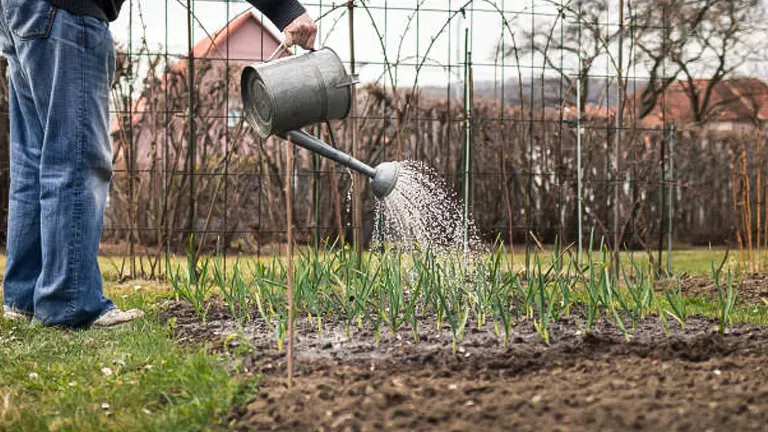
Proper watering after fertilization is crucial for maximizing nutrient uptake and ensuring the health of garlic plants. The strategy involves balancing soil moisture to optimize conditions for nutrient absorption without causing nutrient leaching or root diseases.
Key Principles of Watering Post-Fertilization
- Moisture Balance: Maintain consistent soil moisture levels. Garlic requires soil that is moist but not waterlogged. Overly dry conditions can hinder nutrient dissolution and uptake, while excessively wet conditions can lead to nutrient leaching and root rot.
- Watering Depth and Frequency: Aim to wet the soil to a depth of 6-8 inches (15-20 cm), which encourages deep root growth and maximizes nutrient accessibility. The frequency of watering will depend on soil type, weather conditions, and plant growth stage, with more frequent watering needed in dry, hot periods.
- Monitoring Soil Moisture: Use a soil moisture meter or the finger test (inserting a finger into the soil up to the second knuckle; if the soil feels dry at that depth, it’s time to water) to gauge when watering is needed. Avoid relying solely on a fixed schedule, as varying environmental conditions can significantly impact soil moisture levels.
- Impact of Fertilizer Type: The type of fertilizer applied influences watering needs. Inorganic fertilizers may require more immediate watering to prevent root burn and ensure that nutrients are quickly dissolved and made available to plants. Organic fertilizers release nutrients more slowly and can benefit from lighter, more consistent watering to maintain optimal soil conditions for microbial activity, which is essential for nutrient breakdown and uptake.
Guidelines for Watering Garlic Post-Fertilization
| Soil Type | Watering Depth | Frequency | Notes |
|---|---|---|---|
| Sandy | 6-8 inches | More frequent | Sandy soils drain quickly. Monitor closely and water more often to maintain moisture. |
| Loamy | 6-8 inches | Moderate | Ideal soil type. Retains moisture well while providing good drainage. |
| Clay | 6-8 inches | Less frequent | Clay soils retain water longer. Be cautious to prevent overwatering and waterlogging. |
Scientific Analysis and Considerations
- Nutrient Leaching: Watering practices post-fertilization should minimize the risk of nutrient leaching, where essential nutrients are washed beyond the reach of garlic roots. Research suggests that a balanced approach to irrigation, avoiding extremes of too much or too little water, significantly reduces nutrient loss. For example, nitrate (a form of nitrogen) is particularly susceptible to leaching in over-irrigated or heavily rained-on soils.
- Soil pH and Water Quality: The pH of the water used for irrigation can affect soil pH over time, influencing nutrient availability. Use rainwater or pH-neutral water when possible, especially in areas with hard tap water, to maintain the optimal soil pH for garlic growth (6.0 to 7.0).
- Evapotranspiration Rates: Understanding the concept of evapotranspiration (ET) – the sum of evaporation from the soil surface plus plant transpiration – can guide more efficient watering practices. ET rates vary by climate, weather conditions, and plant growth stages, with higher rates seen during hot, dry, and windy conditions. Adjust watering accordingly to replace the water lost through ET and support optimal garlic growth.
Advanced Tips for Maximizing Garlic Yield
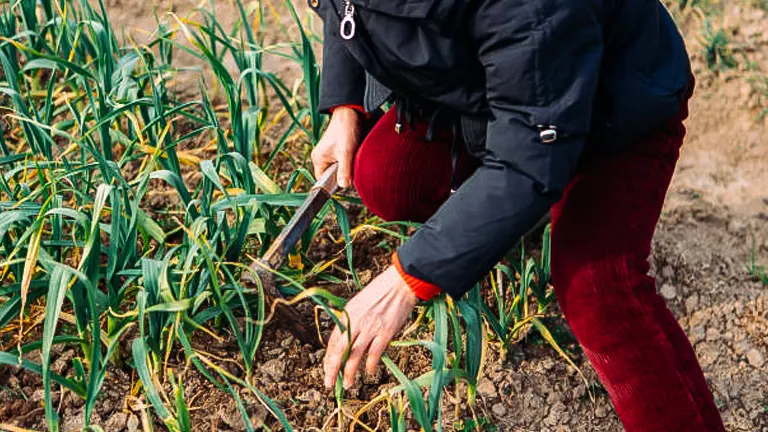
Beyond basic fertilization, these strategies can further enhance your garlic crop’s productivity and health.
Adjusting Fertilization Based on Soil Type and Weather Conditions:
- Soil Type Considerations: Understanding the water-holding capacity and nutrient retention characteristics of your soil type is crucial. Sandy soils, with their quick drainage and low nutrient-holding capacity, require more frequent but smaller fertilizer applications to prevent nutrient leaching. In contrast, clay soils, which hold nutrients and water more effectively, might need less frequent but potentially higher-volume applications to avoid waterlogging and ensure nutrients are available to the garlic roots.
- Weather Adjustments: Garlic’s nutrient uptake can be influenced by weather conditions. During periods of drought, soil moisture levels can drop, reducing the plant’s ability to absorb nutrients. Slightly increasing fertilizer rates or using foliar feeds can help offset this reduction. Conversely, in wet conditions, reducing fertilizer application can minimize nutrient leaching and prevent over-saturation of the soil.
The Importance of Crop Rotation and Companion Planting:
- Crop Rotation: Implementing a crop rotation system with garlic can significantly enhance soil health and reduce the risk of soil-borne diseases and pest infestations. Rotating garlic with nitrogen-fixing crops such as beans or peas can naturally replenish nitrogen levels in the soil, reducing the need for synthetic fertilizers.
- Companion Planting: Growing garlic alongside certain crops can offer multiple benefits, including pest deterrence and improved growth conditions. For instance, planting garlic near tomatoes can repel red spider mites, while positioning it around fruit trees can discourage borers. Companion planting can also create a more biodiverse environment, attracting beneficial insects and promoting a healthier garden ecosystem.
Dealing with Pests and Diseases: Preventive Measures:
- Maintaining a healthy crop through balanced fertilization is your first line of defense against pests and diseases. Excessive nitrogen can lead to lush foliage that attracts aphids and other pests, while a balanced nutrient supply supports strong growth and resilience.
- Implementing integrated pest management (IPM) strategies, such as using biological controls (beneficial insects), physical barriers (row covers), and maintaining garden hygiene (removing diseased plant material), can effectively reduce pest and disease pressure without reliance on chemical pesticides.
Fertilization and Cultivation Strategies
| Strategy | Action Items | Expected Outcome |
|---|---|---|
| Soil & Weather Adaptation | – Adjust fertilization frequency and volume based on soil type and moisture levels. | Optimized nutrient availability and uptake. |
| Crop Rotation | – Rotate garlic with nitrogen-fixing crops (e.g., beans, peas). | Improved soil fertility and reduced pest/disease risk. |
| Companion Planting | – Plant garlic near crops like tomatoes and fruit trees for pest deterrence. | Enhanced growth conditions and biodiversity. |
| Integrated Pest Management | – Employ biological controls, physical barriers, and garden hygiene practices. | Reduced pest and disease impact with minimal chemical use. |
Unique Insights and Scientific Analysis
- Soil Nutrient Dynamics: Research indicates that soil microbial activity, crucial for nutrient cycling and availability, can be significantly influenced by soil texture and moisture levels. Sandy soils, for example, have been found to have lower microbial biomass due to rapid moisture loss and nutrient leaching, affecting plant nutrient uptake efficiency.
- Crop Rotation Impact: Studies have shown that crop rotation can lead to a reduction in specific soil-borne pathogens, such as Fusarium spp., which are detrimental to garlic. The practice of rotating with non-host crops disrupts the life cycles of these pathogens, contributing to healthier soils and stronger plants.
- Companion Planting Efficacy: Scientific investigations into companion planting have revealed that certain plant combinations can indeed influence pest behavior and crop health. For instance, the volatile compounds released by garlic have been identified as effective in repelling or confusing pests that would otherwise target adjacent crops.
Related Post
- How to Fertilize a Mango Tree Effectively: Tips and Tricks for Healthy Growth
- How to Fertilize Apple Trees: Essential Tips for a Bountiful Harvest
- How to Fertilize Lemon Trees: Secrets for Thriving Citrus
- How to Fertilize Avocado Tree: A Step-by-Step Guide for Lush Growth
Conclusion
In the pursuit of a flourishing garlic harvest, the secret lies in mastering the art of fertilization. This comprehensive guide has armed you with the knowledge to understand your soil, choose the right fertilizers, and time your applications to coincide with garlic’s growth stages. By tailoring your approach to the unique needs of your crop, and with a watchful eye on the balance of nutrients, you’re now equipped to nurture your garlic from planting to harvest. With these guidelines, you can look forward to a bountiful yield of this beloved culinary staple.
FAQs
- When is the best time to start fertilizing garlic?
Begin fertilizing garlic at two critical points: apply a balanced fertilizer rich in phosphorus at planting time to encourage strong root development, and then introduce a nitrogen-rich fertilizer in early spring as green shoots appear to promote vigorous leaf growth. - How do soil types affect garlic fertilization?
Soil type significantly influences fertilization strategy. Sandy soils, which drain quickly and have low nutrient retention, require more frequent but lighter applications of fertilizer to prevent leaching. Clay soils, with higher nutrient retention but slower drainage, might need fewer, more concentrated applications to ensure nutrients are available without risking waterloging the plants. - Can over-fertilizing garlic be harmful?
Yes, over-fertilizing, especially with nitrogen, can lead to lush foliage at the expense of bulb development. It can also increase the plant’s susceptibility to diseases and pests. It’s crucial to follow recommended fertilizer rates and adjust based on soil testing. - What role does compost play in fertilizing garlic?
Compost enriches the soil with organic matter, improves soil structure, enhances moisture retention, and provides a slow-release source of nutrients. Incorporating compost into your garlic bed before planting helps create an ideal growing environment for garlic. - Is it necessary to water garlic immediately after fertilizing?
Yes, watering after fertilizing helps dissolve and distribute the nutrients in the soil, making them more accessible to the garlic plants. However, avoid over-watering to prevent nutrient leaching. - How does crop rotation benefit garlic fertilization?
Crop rotation helps maintain soil health by preventing nutrient depletion and reducing the buildup of pests and diseases. Rotating garlic with nitrogen-fixing crops like legumes can naturally replenish nitrogen in the soil, reducing the need for synthetic fertilizers. - What are the signs of nutrient deficiency in garlic?
Nutrient-deficient garlic may exhibit yellowing leaves (nitrogen deficiency), poor root development (phosphorus deficiency), or weak overall growth and disease resistance (potassium deficiency). Addressing deficiencies promptly with targeted fertilization can help restore plant health. - Can the timing of the last fertilizer application affect garlic bulb size?
Yes, the timing of the final fertilizer application can impact bulb size. Cease nitrogen fertilization by late spring to early summer to ensure the plant focuses energy on bulb development rather than leaf growth. This strategic timing helps maximize bulb size and quality.
We hope this guide has illuminated the path to enriching your garlic cultivation journey. Armed with these insights, you’re now ready to elevate your garlic game to new heights. Here’s to a season of abundant and flavorful garlic harvests!
Dive deeper into expert gardening strategies by exploring our comprehensive guides, uncover our top picks in the best section, and gain detailed insights through our product reviews.

Benjamin Brooks
Forestry AuthorGreetings! I'm Benjamin Brooks, and my journey over the past 15 years has revolved around the fascinating realms of content creation, expertise in snow clearing, and the intricate world of lumberjacking and landscaping. What began as a simple curiosity about the natural world and heavy machinery has evolved into a passionate profession where my love for crafting words intertwines seamlessly with my lumberjacking and garden skills.











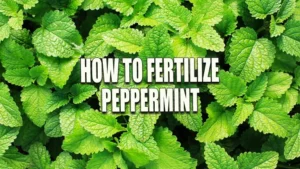

Leave your comment